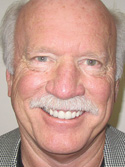Ground quiet so far near proposed Weathersfield injection well


Klingle
By Ed Runyan
WEATHERSFIELD
The ground near the proposed American Water Management Services Inc. brine-injection well along state Route 169 just north of Niles has been quiet since November.
If it remains that way over the next couple of months, the company will be ready to start commercial injection of the brine that comes from gas and oil drilling, including the newer horizontal wells that use hydraulic fracturing.
Mark Bruce, spokesman for the Ohio Department of Natural Resources, said Thursday that seismometers in the ground at the site have picked up “no seismic activity [ground movement] at all” since the monitoring began in November.
That monitoring has established what Bruce called a “baseline,” meaning a base against which later measurements can be compared.
American Water Management will carry out tests in the coming weeks that its president, Ron Klingle, believes will lead to ODNR approval to begin commercial brine injection in six to eight weeks.
Over that time, construction of a building and other above-ground facilities also will continue, Klingle said.
Bruce noted that the seismic monitoring the state has done in recent months in other parts of the state have picked up small earthquakes too mild to be felt by humans.
The equipment has detected seismic events occurring many miles away. In the case of the Weathersfield site, only “noise signals,” possibly from quarrying work, were picked up, Bruce said.
Klingle said he believes the noise signals detected were the result of trucks on cement pads at the site.
In the coming weeks, the Howland-based company and ODNR will monitor tests the company will carry out at the well, which was drilled last fall.
American Water Management will inject brine into the well to test the “integrity,” or soundness, of the well and to check for seismic activity in relation to water being pumped into the well under pressure, Bruce said.
The seismic monitoring done so far and the monitoring that will continue for 12 months after commercial injection begins are part of changes in Ohio law approved in the summer of 2012, in response to the 4.0-magnitude Dec. 31, 2011, earthquake near the Northstar 1 injection well in Youngstown. Many smaller earthquakes also occurred in the months before that.
Ohio law requires seismic monitoring for any injection well — such as the Weathersfield well — that propose to dispose of gas and oil drilling wastes in the Mount Simon and Knox geological formations.
The Weathersfield well, which is four-tenths of a mile northwest of the North Road-North Main Street intersection in Niles, will inject brine 9,100 feet deep.
Scientists believe the Youngstown earthquakes occurred because injection pressure caused slippage of existing geological faults in the Precambrian formation, which is just below the Mount Simon and Knox formations.
American Water Management also plans to inject oil and gas wastes into a second well at the same site that will be 4,700 feet deep, which will inject brine into the Newburg formation, which was not implicated in the earthquakes.
Klingle said both wells are expected to provide the company with a place where brine can be injected for many years to come because the geological formations involved are an “ideal place” to put the fluids.
The site has a lined earthen “impoundment” area designed to hold any brine that would escape from holding tanks. Bruce referred to the impoundment area at the Weathersfield site as a “dike,” saying it has to be large enough to hold 110 percent of the fluid in the tanks.
Klingle said critics of the oil and gas industry sometimes describe pondlike structures being used to hold brine, but that is not what the impoundment area at the Weathersfield well is.
“You’ll never see water in it,” Klingle said. “It’s only if the tank fails.”
A Jan. 8 news release by the group Frackfree Mahoning Valley mentions the Weathersfield injection well, saying the proposed well’s “close proximity to the epicenter of the 2011 Youngstown 4.0 magnitude quake shows inadequate concern by ODNR for public health and safety.”
It quoted geologist Suzie Beiersdorfer, a member of Frackfree Mahoning Valley, saying, “Our position is that the injection wells must stop now as a measure to protect the public’s health, safety and well-being.”
Klingle said there won’t be earthquakes or groundwater contamination associated with the Weathersfield injection well.
“We wouldn’t be putting the amount of money into this if there was any chance of that happening,” Klingle said. “It’s going to be 100 percent safe. We wouldn’t do it any other way.”
Klingle said the creation of injection wells in the Mahoning Valley is important to helping the gas and oil industry grow here.
“It has to go someplace,” he said of the waste fluids from gas and oil drilling. “This is the absolute best way to dispose of it. We have to be able to do this or the gas and oil companies ... are not going to drill. They’ll go someplace else where they can.”
 43
43
